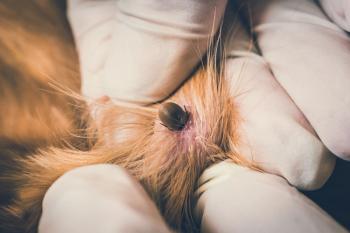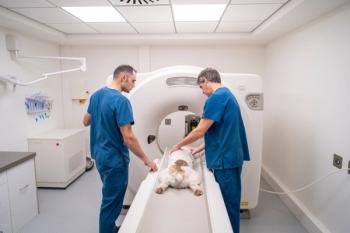
Options exist for management of tracheobronchial disease
Q: Could you provide a practical review of drugs used in the clinical management of tracheobronchial disease in older dogs and cats?
Q: Could you provide a practical review of drugs used in the clinical management of tracheobronchial disease in older dogs and cats?
At the recent 138th American Veterinary Medical Association Annual (AVMA)Convention, Dr. Patricia M. Dowling, diplomate of ACVIM and ACVCP and fromthe Western College of Veterinary Medicine presented an excellent reviewof drugs used in the clinical management of tracheobronchial disease inolder dogs and cats. The practical content of the lecture is provided below.
Codeine is still commonly used as an effective antitussive agent.Codeine phosphate and codeine sulfate are found in many preparations includingtablets, liquids and syrups.
Codeine has analgesic effects that are approximately one-tenth that ofmorphine, while its antitussive potency is approximately equal to that ofmorphine. The side effects of codeine are significantly less than thoseexperienced with morphine at antitussive doses.
Signs of adverse drug effects, especially in cats, are excitement, muscularspasms, convulsions, respiratory depression, sedation and constipation.The potential for addiction and abuse is considerably lower than for morphine.The recommended dosage in dogs is 1-2 mg/kg orally every six to 12 hours.
Hydrocodone is chemically and pharmacologically similar to codeine,but more potent. Hydrocodone is combined with an anticholinergic agent (homatropine)in the commercial product Hycodan. The dosage is approximately 0.25mg/kg orally every six to 12 hours. Hycodan should be used with cautionin cats.
Dextromethorphan
Dextromethorphan is contained in the antitussive product Robitussin,which also contains guaifenesin, a centrally acting muscle relaxant andexpectorant effect by stimulating bronchial secretions. One should generallyforgo antitussive therapy if there is productive cough. It is better touse dextromethorphan as a single substance than in a cough medicine combination.Even though dextromethorphan is not a real opioid, intoxications can oftenbe treated with naloxone.
Caution should always be used in the treatment of advanced respiratoryinsufficiency and hepatic disease. In combination with monoamine oxidaseinhibitors, dextromethorphan can cause a severe reaction (serotogenic syndromewith fever, hypertension, arrhythmias); avoid this combination if possible!Dextromethorphan is administered to dogs at 0.5-1 mg/kg orally every eightto 12 hours. Dextromethorphan is more efficacious in cats than codeine ata dosage of 2-4 mg/kg. Dextromethorphan is the safest antitussive productto use in cats.
Butorphanol
Butorphanol (Torbutrol or Torbugesic) is approved as an analgesicand antitussive. It is more potent than morphine as an analgesic and morepotent than codeine or dextromethorphan as an antitussive. It may produceconsiderable sedation. The parenteral dosage is 0.05-0.1 mg/kg intravenouslyor subcutaneously every six to 12 hours. It has a poor bioavailability,so the oral dosage in dogs is 0.55-1.1 mg/kg.
Isoproterenol (Isuprel) is a potent ß-adrenergic receptoragonist. It is selective for ß receptors, but its cardiac effectsmake it unsuitable for long-term use. It can be administered by inhalationor injection. It also has a short duration of action (less than one hour).In dogs, administer 0.1-0.2 mg intramuscularly or subcutaneously every sixhours. In cats, administer 4-6 mcg intramuscularly every 30 minutes as needed.
Terbutaline
Terbutaline (Brethine or Bricanyl) is similar to isoproterenolin its ß receptor activity but is longer acting (six to eight hours).It may be injected subcutaneously to relieve an acute episode of bronchoconstriction.For cats with frequent, severe bronchoconstrictive disease while receivingchronic oral therapy, injectable terbutaline can be dispensed with instructionsto administer 0.25 mg subcutaneously to abort respiratory distress episodesat home within 15 minutes, and it may be repeated if necessary.
An increase in the cat's heart rate to 240 beats per minute and a 50percent decrease in respiratory rate indicate a positive drug effect. Terbutalinecan also be given as chronic oral therapy at 0.625 mg per cat every 12 hours(of a 2.5 mg tablet) and 2.5 mg per dog every eight hours. Albuterol issimilar to terbutaline and is used in dogs. Albuterol base is salbutamol(Proventil or Ventolin). The dose for dogs is 0.05 mg/kg orally every eighthours. It is also available in a metered dose inhaler. Salmeterol xinafoate(Serevent) is in a new class of selective, long-acting (12 hours), slow-onset(10-20 minutes) ß receptor agonist available in a metered dose inhaler.
Bronchodilators
The methylxanthines relax bronchial smooth muscle and are referredto as bronchodilators. Theophylline, aminophylline and oxytriphyllineare the most commonly used oral methylxanthines in veterinary medicine.
Theophylline is poorly soluble in water and may produce GI irritationwhen administered orally. Aminophylline is a theophylline salt thatis 78-86 percent theophylline. It is more water-soluble and produces lessGI irritation. The dosage for aminophylline in dogs is 10 mg/kg orally everyeight hours and in cats is 5 mg/kg orally every 12 hours. There are severalsustained release formulations of theophylline that are suitable for usein older dogs and cats.
Slo-Bid and Theo-Dur brands of theophylline may be administeredto dogs at 10-20 mg/kg orally every 12 hours, and Choledyl-SA (oxytriphylline)may be administered at a dose of 47 mg/kg orally every 12 hours. Slo-Bidand Theo-Dur may be administered to cats at an oral dosage of 25 mg/kg every24 hours (best given in the morning).
Glucocorticoids
The glucocorticoids inhibit the release of inflammatory mediators frommacrophages and eosinophils, resulting in the decreased synthesis of prostaglandins,leukotrienes and platelet-activating factor.
Studies indicate glucocorticoids may enhance the action of adrenergicagonists on ß receptors in the bronchial smooth muscle. In older dogsand cats, oral prednisone or prednisolone is usually the preferred drugfor chronic therapy of tracheobronchial inflammation.
A typical anti-inflammatory dosage is 0.5-1 mg/kg, with chronic therapyon an every other day basis. Cats are somewhat resistant to the effectsof glucocorticoids and a dosage of 1 mg/kg daily is used in the chronictherapy of feline asthma or 20 mg of methylprednisolone acetate (Depo-Medrol)intramuscularly every three weeks.
For emergency treatment of dyspneic cats, use of a shock dose of an intravenousprednisone sodium succinate 5-10 mg/kg or dexamethasone sodium phosphate1-2 mg/kg is recommended.
Metered dose inhalers
Glucocorticoid preparations in metered dose inhalers offer a promisingmethod of drug delivery for asthmatic cats. Relatively inexpensive infantunits for inhalation therapy are available (Opti-Chamber or Aero-Chamber)and are reasonably well tolerated.
Cats with mild asthmatic signs can be treated with a bronchodilator,such as albuterol (Ventolin) 90 mcg (one puff) as needed and 110 mcg (onepuff) of fluticasone (Flovent) BID. Cats with moderate asthmatic signs canbe treated with 90 mcg (one puff) of albuterol as needed, five-day courseof prednisone orally at 1 mg/kg and 220 mcg (two puffs) of fluticasone BID.
Severely affected cats should be treated on an emergency basis with oxygen,an intravenous dose of a steroid and 90 mcg (one puff) of albuterol every30 minutes as needed. Chronic therapy should include 220 mcg (two puffs)of fluticasone BID, 90 mcg (one puff) of albuterol as needed, and 1 mg/kgof prednisone every other day. Inhaled medications may also benefit dogswith chronic sinusitis and chronic bronchitis.
Cyproheptadine
Cyproheptadine (Periactin) is an antihistamine with anti-serotonin activity.Because of the role of serotonin in allergen-induced bronchoconstrictionin cats, cyproheptadine may be used in asthmatic cats to block bronchoconstrictionas adjunct to corticosteroids and bronchodilators.
Cyproheptadine is dosed at 2 mg orally every 12-24 hours for chronictreatment of asthmatic cats. Because of its long elimination half-life (12hours), it requires several days to reach steady-state concentrations andmay take four to seven days to be clinically effective. Cyproheptadine serotoninantagonism in the appetite center may cause an appetite stimulant effectin cats, so weight gain may be a problem.
Lethargy, depression and increased appetite may occur within 24 hoursof initiating therapy.
Newsletter
From exam room tips to practice management insights, get trusted veterinary news delivered straight to your inbox—subscribe to dvm360.




